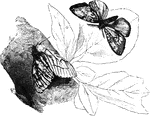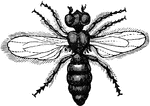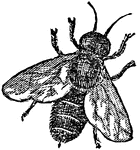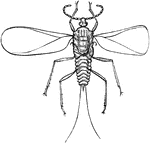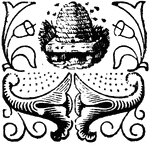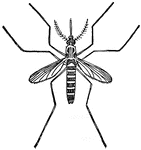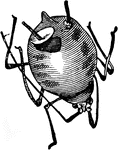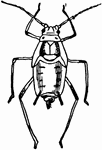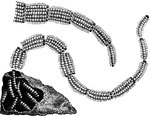
Processionary Caterpillars
"If the guide stops a moment all the followers halt; if he continues the route, they all hasten after…

Fidonia Plumistaria
"The European Fidonia Plumistaria, is distinguised by its curious feathery antennae." —…
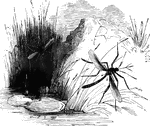
Gnats
"In the family Culicidae, or Gnats, which include several pre-eminently bloodthirsty species,…

Mosquitos
"The Mosquitos, Colex musquito, which are very nearly allied to the gnats, are still greater…
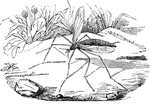
Crane Fly
"The tipulidae have the proboscis short, terminated by a pair of fleshy lips, inclosing two bristles."…
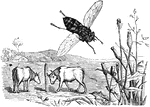
Ox Fly
"The Ox-fly, Oestrus bovis, is three-forths of an inch long, and lays its eggs in the skin of young…
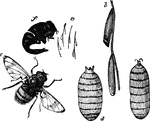
Breeze Fly
"a, eggs of the Breeze-fly; b, the same magnified; c, larva, or bot; d, chrysalis; e, perfect insect;…

Flea
"Aphaniptera includes the fleas, which, despite their minuteness, have made themselves a name in the…
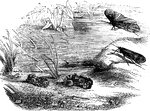
Great Red Sedge and Larva
"The Phrygania striata is over an inch long, of a fawn-color, with the exception of the eyes,…
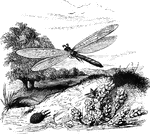
Antlion and Larva
"In some species the larvae, which are small, sluggish, oval-shaped creatures, and furnished with a…

Eleanor Dragonfly
"Among the larger kinds of dragon-fly is the Libellula depressa of Linnaeus, common in Europe,…
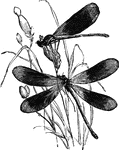
Virgin Dragonfly
"One of the most beautiful species of Euopean dragonflies is the Virgin Dragon-fly, Libellela virgo,…
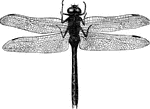
American Dragonfly
"They are often seen moving with a rapid flight over rivers, ponds, and meadows, alighting for a moment,…
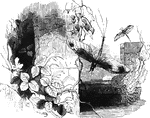
May Fly
"These insects are called Day-flies from the shortness of their existence in the perfect state;…
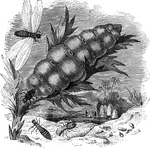
White Ants
"These animals, often called White Ants, live in vast communities, principally in the hotter…

Common Cockroach
"Blattina includes the Cockroaches, the most noted species of which, the Black beetle or Common…

Walking Leaf
"The Phasmina includes some curious insects, one species of which is the Walking-leaf, Phyllium…
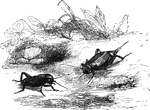
Field Cricket
"Another species of cricket is the Field-cricket, a timid animal which avoids the society of man, living…
!["Like that animal [the mole] it is constantly engaged in burrowing in the earth; and to enable it to do this with facility iits anterior limbs are converted into a pair of flat, fossorial organs, which are turned outward in exactly the same manner as the hand of the mole. In its pasage through the earth it does great injury to the roots of plants, but it said to live quite as much upon animal as vegetable food." — Goodrich, 1859](https://etc.usf.edu/clipart/14900/14935/molecricket_14935_mth.gif)
Mole Cricket
"Like that animal [the mole] it is constantly engaged in burrowing in the earth; and to enable it to…
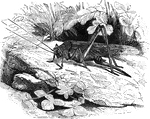
Carolina Grasshopper
"The Carolina Grasshopper, Gryllus Carolina, is a large species with brown wings, common in…

Locusts
"Locusts, which, from their often collecting in vast swarms, and moving onward with a steady and irresistable…
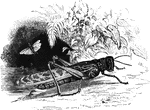
Locusta Cristata
"The migratory locust measures about two and a half inches in length, and some other exotic species…

Boat Fly
"They carry the air required for their respiration in a space left for this purpose between the wings…

Water Scorpion
"The Nepa cinerea is a European example of this family, which may be met with there in every…
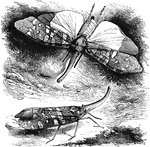
Lantern Fly
"The family of Fulgorina includes the Lantern-flies, of which a large species inhabiting…

Cicada
"In America the cicadas have the general name of Harvest-flies; they are also often improperly…
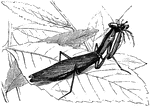
Praying Mantis
"The Mantis is one of the most voracious of its class, and only assumes this solemn and devout appearance…

Electric scolopendra
"The Electric Scolopendra, S. electrica, is a European species, luminous in the dark." —…

Giant Centipede
"A Centipede is a worm having a long slender, depressed body, protected by coriaceous plates, 21 pairs…
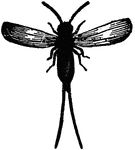
Male Cochineal Insect
"Cochineal is a dye-stuff employed in dyeing scarlet and crimson; consists of the bodies of the femals…

Female Cochineal Insect
"Cochineal is a dye-stuff employed in dyeing scarlet and crimson; consists of the bodies of the femals…
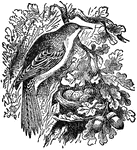
Common Creeper
"Creepers are a family of birds which strongly resemble the woodpeckers in their habit of creeping on…

Dragonfly
"The Dragon Fly has a large, broad head, very freely attached to the thorax, and large, convex, prominent…
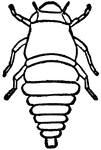
Larval Frog Hopper
"Frog Hoppers are ranked under the homopterous sub-order of insects. The name of frog hopper refers…
Frog Hopper on Leaf
"Frog Hoppers are ranked under the homopterous sub-order of insects. The name of frog hopper refers…

Adult Frog Hopper
"Frog Hoppers are ranked under the homopterous sub-order of insects. The name of frog hopper refers…
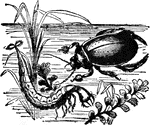
Water Beetle
"Water Beetles are beetles which live on or in the water. The Dytiscus, common in stagnant water, is…
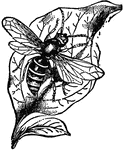
Hornet
"Hornet is the largest species of wasp found in America. The thorax is mostly black; the abdomen is…
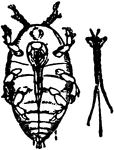
Phylloxera
"Pylloxera is a genus of insects allied to the Aphis and Coccus families. The Phylloxeridæ attach…
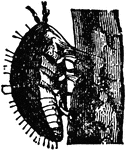
Phylloxera
"Pylloxera is a genus of insects allied to the Aphis and Coccus families. The Phylloxeridæ attach…
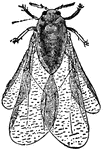
Phylloxera
"Pylloxera is a genus of insects allied to the Aphis and Coccus families. The Phylloxeridæ attach…

Seventeen Year Locust
The Seventeen Year Locust (Cicada septendecim) spends seventeen years underground feeding on the roots…

Spider Fly
"Spider Fly is a genus of dipterous insects, chiefly allied to the forest fly. The insects are parasitical…
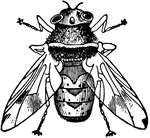
Mature Botfly
"After attaching themselves to the walls of the stomach, the botfly larva are nourished by the blood…
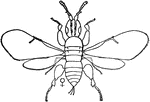
Fig Insect
"The fig insect will not lay eggs in the Smyrna fig, but only in the wild fig; therefore one individual…
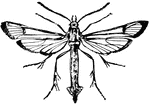
Clear-Winged Moth
"These are wasplike moths of brilliant colors and have transparent wings. They generally fly by day."…

Hop Louse
"Hop louse which lives on the plum tree in the late fall, winter, and early spring until the hop vines…
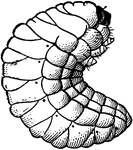
Pea Weevil
"The pea weevil is often found in peas in its larval state during summer and autumn, as a pupa in winter,…
